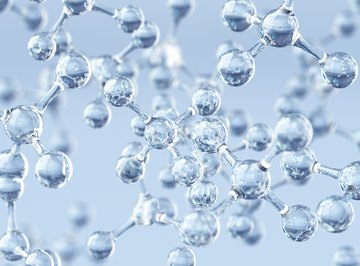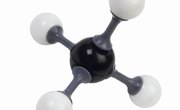
Biology – or informally, life itself – is characterized by elegant macromolecules that have evolved over hundreds of millions of years to serve a range of critical functions. These are often categorized into four basic types: carbohydrates (or polysaccharides), lipids, proteins and nucleic acids. If you have any background in nutrition, you will recognize the first three of these as the three standard macronutrients (or "macros," in dieting parlance) listed on nutritional information labels. The fourth pertains to two closely related molecules that serve as the basis for the storage and translation of genetic information in all living things.
Each of these four macromolecules of life, or biomolecules, performs a variety of duties; as you might expect, their different roles are exquisitely related to their various physical components and arrangements.
Macromolecules
A macromolecule is a very large molecule, usually consisting of repeated subunits called monomers, which cannot be reduced to simpler constituents without sacrificing the "building block" element. While there is no standard definition of how large a molecule must be to earn the "macro" prefix, they generally have, at a minimum, thousands of atoms. You have almost certainly seen this kind of construction in the non-natural world; for example, many kinds of wallpaper, while elaborate in design and physically expansive on the whole, consist of adjoining subunits that are often less than a square foot or so in size. Even more obviously, a chain can be regarded as a macromolecule in which the individual links are the "monomers."
An important point about biological macromolecules is that, with the exception of lipids, their monomer units are polar, meaning that they have an electric charge that is not distributed symmetrically. Schematically, they have "heads" and "tails" with different physical and chemical properties. Because the monomers join head-to-tail to each other, macromolecules themselves are also polar.
Also, all biomolecules have high amounts of the element carbon. You may have heard the kind of life on Earth (in other words, the only kind we know for certain exists anywhere) referred to as "carbon-based life," and with good reason. But and nitrogen, oxygen, hydrogen, and phosphorus are indispensable to living things as well, and a host of other elements are in the mix to lesser degrees.
Carbohydrates
It is a near-certainty that when you see or hear the word "carbohydrate," the first thing you think of is "food," and perhaps more specifically, "something in food a lot of people are intent on getting rid of." "Lo-carb" and "no-carb" both became weight-loss buzzwords in the early part of the 21st century, and the term "carbo-loading" has been around the endurance-sports community since the 1970s. But in fact, carbohydrates are far more than just a source of energy for living things.
Carbohydrate molecules all have the formula (CH2O)n, where n is the number of carbon atoms present. This means that the C:H:O ratio is 1:2:1. For example, the simple sugars glucose, fructose and galactose all have the formula C6H12O6 (the atoms of these three molecules are, of course, arranged differently).
Carbohydrates are classified as monosaccharides, disaccharides and polysaccharides. A monosaccharide is the monomer unit of carbohydrates, but some carbohydrates consist of only one monomer, such as glucose, fructose and galactose. Usually, these monosaccharides are most stable in a ring form, which is depicted diagrammatically as a hexagon.
Disaccharides are sugars with two monomeric units, or a pair of monosaccharides. These subunits can be the same (as in maltose, which consists of two joined glucose molecules) or different (as in sucrose, or table sugar, which consists of one glucose molecule and one fructose molecule. Bonds between monosaccharides are called glycosidic bonds.
Polysaccharides contain three or more monosaccharides. The longer these chains are, the more likely they are to have branches, that is, to not simply be a line of monosaccharides from end to end. Examples of polysaccharides include starch, glycogen, cellulose and chitin.
Starch tends to form in a helix, or spiral shape; this is common in high-molecular-weight biomolecules in general. Cellulose, in contrast, is linear, consisting of a long chain of glucose monomers with hydrogen bonds interspersed between carbon atoms at regular intervals. Cellulose is a component of plant cells and gives them their rigidity. Humans cannot digest cellulose, and in the diet it is usually referred to as "fiber." Chitin is another structural carbohydrate, found in the outer bodies of arthropods like insects, spiders and crabs. Chitin is a modified carbohydrate, as it is "adulterated" with ample nitrogen atoms. Glycogen is the body's storage form of carbohydrate; deposits of glycogen are found in both liver and muscle tissue. Thanks to enzyme adaptations in these tissues, trained athletes are able to store more glycogen than sedentary people as a result of their high energy needs and nutritional practices.
Proteins
Like carbohydrates, proteins are a part of most people's everyday vocabulary because of their serving as a so-called macronutrient. But proteins are incredibly versatile, far more so than carbohydrates. In fact, without proteins, there would be no carbohydrates or lipids because the enzymes needed to synthesize (as well as digest) these molecules are themselves proteins.
The monomers of proteins are amino acids. These include a carboxylic acid (-COOH) group and an amino (-NH2) group. When amino acids join to each other, it is via a hydrogen bond between the carboxylic acid group on one of the amino acids and the amino group of the other, with a molecule of water (H2O) released in the process. A growing chain of amino acids is a polypeptide, and when it is sufficiently long and assumes its three-dimensional shape, it is a full-fledged protein. Unlike carbohydrates, proteins never show branches; they are just a chain of carboxyl groups joined to amino groups. Because this chain must have a beginning and an end, one end has a free amino group and is called the N-terminal, while the other has a free amino group and is called the C-terminal. Because there are 20 amino acids, and these can be arranged in any order, the composition of proteins is extremely varied even though no branching occurs.
Proteins have what is called primary, secondary, tertiary and quarternary structure. Primary structure refers to the sequence of amino acids in the protein, and it is genetically determined. Secondary structure refers to bending or kinking in the chain, usually in a repetitive fashion. Some conformations include an alpha-helix and a beta-pleated sheet, and result from weak hydrogen bonds between side chains of different amino acids. Tertiary structure is the twisting and curling of the protein in three-dimensional space and can involve disulfide bonds (sulfur to sulfur) and hydrogen bonds, among others. Finally, quaternary structure refers to more than one polypeptide chain in the same macromolecule. This occurs in collagen, which consists of three chains twisted and coiled together like a rope.
Proteins can serve as enzymes, which catalyze biochemical reactions in the body; as hormones, such as insulin and growth hormone; as structural elements; and as cell-membrane components.
Lipids
Lipids are a diverse set of macromolecules, but they all share the trait of being hydrophobic; that is, they do not dissolve in water. This is because lipids are electrically neutral and therefore nonpolar, whereas water is a polar molecule. Lipids include triglycerides (fats and oils), phospholipids, carotenoids, steroids and waxes. They are involved chiefly in cell membrane formation and stability, form portions of hormones, and are used as stored fuel. Fats, a type of lipid, are the third type of macronutrient, with carbohydrates and proteins discussed previously. Via oxidation of their so-called fatty acids, they supply 9 calories per gram as opposed to the 4 calories per gram supplied by both carbohydrates and fats.
Lipids are not polymers, so they come in a variety of forms. Like carbohydrates, they consist of carbon, hydrogen and oxygen. Triglycerides consist of three fatty acids joined to a molecule of glycerol, a three-carbon alcohol. These fatty-acid side chains are long, simple hydrocarbons. These chains can have double bonds, and if they do, that makes the fatty acid unsaturated. If there is only one such double bond, the fatty acid is monounsaturated. If there are two or more, it is polyunsaturated. These different types of fatty acids have different health implications for different people owing to their effects on the walls of blood vessels. Saturated fats, which have no double bonds, are solid at room temperature and are usually animal fats; these tend to cause arterial plaques and may contribute to heart disease. Fatty acids can be chemically manipulated, and unsaturated fats such as vegetable oils can be made saturated so that they are solid and convenient to use at room temperature, like margarine.
Phospholipids, which have a hydrophobic lipid at one end and a hydrophilic phosphate at the other, are an important component of cell membranes. These membranes consist of a phospholipid bilayer. The two lipid portions, being hydrophobic, face to the outside and interior of the cell, while the hydrophilic tails of phosphate meet in the center of the bilayer.
Other lipids include steroids, which serve as hormones and hormone precursors (e.g., cholesterol) and contain a series of distinctive ring structures; and waxes, which include beeswax and lanolin.
Nucleic Acids
Nucleic acids include deoxyribonucleic acid (DNA) and ribonucleic acid (RNA). These are very similar structurally as both are polymers in which the monomeric units are nucleotides. Nucleotides consist of a pentose sugar group, a phosphate group and a nitrogenous base group. In both DNA and RNA, these bases can be one of four types; otherwise, all of the nucleotides of DNA are identical, as are those of RNA.
DNA and RNA differ in three main ways. One is that in DNA, the pentose sugar is deoxyribose, and in RNA it is ribose. These sugars differ by exactly one oxygen atom. The second difference is that DNA is usually double-stranded, forming the double helix discovered in the 1950s by Watson and Crick's team, but RNA is single-stranded. The third is that DNA contains the nitrogenous bases adenine (A), cytosine (C), guanine (G) and thymine (T), but RNA has uracil (U) substituted for thymine.
DNA stores hereditary information. Lengths of nucleotides make up genes, which contain the information, via the nitrogenous base sequences, to manufacture specific proteins. Lots of genes make up chromosomes, and the sum total of an organism's chromosomes (humans have 23 pairs) is its genome. DNA is used in the process of transcription to make a form of RNA called messenger RNA (mRNA). This stores the coded information in a slightly different way and moves it out of the cell nucleus where the DNA is and into the cell cytoplasm, or matrix. Here, other types of RNA initiate the process of translation, in which proteins are made and dispatched all over the cell.
References
About the Author
Kevin Beck holds a bachelor's degree in physics with minors in math and chemistry from the University of Vermont. Formerly with ScienceBlogs.com and the editor of "Run Strong," he has written for Runner's World, Men's Fitness, Competitor, and a variety of other publications. More about Kevin and links to his professional work can be found at www.kemibe.com.
